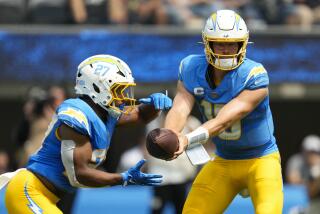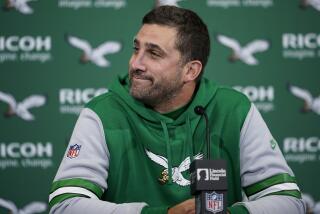College is Knowledge in NFL
- Share via
Bucs, Dolphins and others should take further advantage of spread offense in NFL Excuses spread thin against different offensive mind-set
The best part wasn’t actually watching Miami Dolphins running back Ronnie Brown taking six direct snaps from center, running for three touchdowns and throwing for another.
No, the best part was when the camera flashed to New England’s sideline and showed Bill Belichick -- the poster boy for NFL arrogance and pro football’s resident snooty genius -- wearing a blank, baffled expression that pretty much said, “I think I’ve just been snookered by a college offense.” And it got me thinking about something that’s been in the back of my mind for a long time. Which is this: Forget about Jon Gruden’s sideways offense. If the Tampa Bay Bucs really want to move the football, they should hire Houston Nutt.
Actually, my theory goes much deeper than this. If Brown can account for four touchdowns on six direct snaps while running an old high school formation Nutt made trendy at the University of Arkansas, then why couldn’t a full-blown spread offense be as successful in the NFL as it is in college football?
When I asked Alabama Coach Nick Saban -- the man who drafted Brown when he coached the Dolphins -- this exact question, he didn’t exactly shoot down the idea.
“I thought that someday somebody in the NFL would try this,” Saban said. “It’s very difficult to defend. If you’re not well-prepared for it, which I’m sure New England had no idea, it would be very difficult to have your players adjust to it.” South Carolina’s Steve Spurrier, another former NFL coach, seemed even more excited about the Dolphins bucking convention and trying something outside the realm of pro football’s traditional cookie-cutter offenses.
“They used to always say, ‘You can’t do that in the NFL,’ ” Spurrier said. “But the Dolphins said, ‘Why not? Stop us and we’ll find out.’
“I always thought the Tennessee Titans should let Vince Young run that offense. That’s what he did in college. Of course, they say he’s going to get hit too much and knocked out of the game, but what he does best is run and throw, not just be a dropback passer.” As Spurrier suggests, the common belief is that dual-threat college quarterbacks could never survive the pounding they would take in the NFL.
University of Central Florida Coach George O’Leary, a former NFL defensive coordinator, points out that the huge financial stake NFL teams have in their quarterback precludes them from putting them in the spread and letting them regularly run the ball. Even Florida Coach Urban Meyer, who has been one of the main proliferators of the spread offense in college football, isn’t so sure it’s feasible in the NFL.
“They’ve got some real war daddies coming off the edge in the NFL,” O’Leary said.
“I don’t think the quarterbacks can take the shots,” Meyer added.
Legitimate points, but I don’t necessarily buy them. We’re not talking about running the spread offense with Peyton Manning or Tom Brady at quarterback. We’re talking about drafting a quarterback like Florida’s Tim Tebow, South Florida’s Matt Grothe or West Virginia’s Pat White and molding a spread offense to fit their many talents.
These aren’t slow, brittle, statuesque quarterbacks; these are tough, fast, dual-threat athletes.
Question: Why is it that NFL running backs often make it through the season without getting injured but there is a mind-set that an athletic quarterback cannot?
The NFL smugness when it comes to the spread offense is the same sort of Southeastern Conference snobbery that was prevalent when Meyer was hired by Florida.
The common refrain then among the hoity-toity SEC elitists was, “Tsk-tsk, surely you jest. The spread offense will never work in the SEC. There’s simply far too much speed and physicality on defense.” Uh-huh.
There was so much speed and physicality on SEC defenses last year that Tebow accounted for 55 touchdowns and became the first player in college football history to run and pass each for at least 20 TDs.
The spread has proven it can work in the toughest conference in college football, but there are still plenty who doubt it could ever work in the high-and-mighty NFL.
Then again, their early 20th-century ancestors probably denounced an offensive “novelty” college football adopted before it became generally accepted in the pros. That “novelty” was called the forward pass.
Last time we checked, it seemed to be working out quite well in the NFL.
More to Read
Go beyond the scoreboard
Get the latest on L.A.'s teams in the daily Sports Report newsletter.
You may occasionally receive promotional content from the Los Angeles Times.










